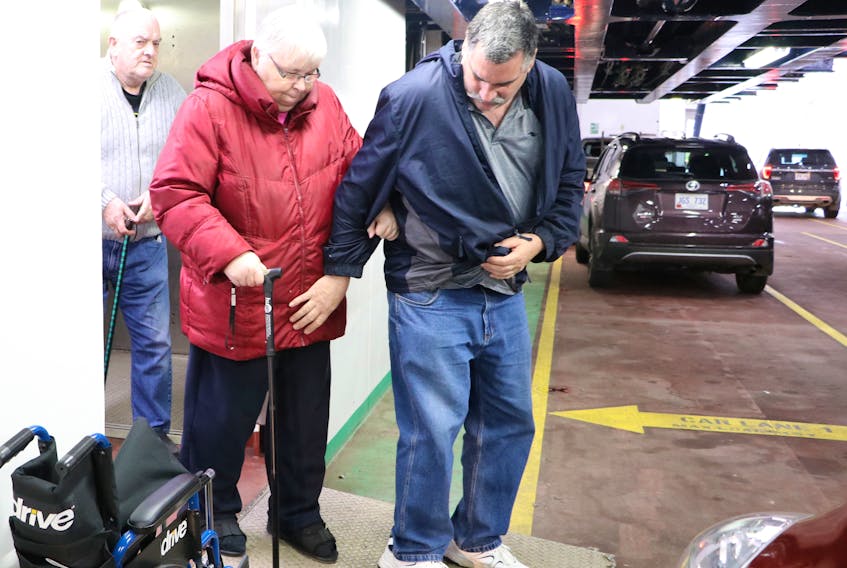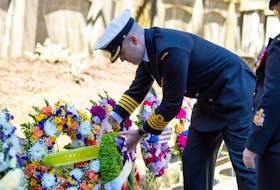When Ed Coxworthy Sr. of Bell Island was about 15 years old, he and two friends decided one day to swim the five kilometres across the tickle between the island in Conception Bay and the cove at Portugal Cove-St. Philip’s.
Returning home on the ferry, he learned that the ship’s captain, who knew his family, had called his mother and told her what he had done.
“I thought at the time it was just as well if I drowned because my mother was going to kill me anyway,” the 78-year-old said on Thursday.
These days, Coxworthy and his wife, Kay Coxworthy, 75, often sail across the tickle on the Bell Island ferry to get to medical appointments.
Ed Coxworthy has had two surgeries on his back and has mobility issues — including the sometimes sudden loss of strength in his left leg that can cause him to fall — and Kay is a cancer survivor with mobility and balance issues.
Both use a cane when walking. And both are among a number of Bell Island residents who want to be able to remain in their vehicles during the approximately 20-minute ferry crossing.
Since the new ferry MV Legionnaire came into service in late July, however, rules are being strictly enforced on all provincial ferries that passengers are not allowed to remain in their vehicles during ferry crossings. The MV Flanders is the other ferry on the Bell Island run.
Kay Coxworthy said that, before she retired years ago, she would commute daily on the ferries for work in St. John’s and people could always stay in their vehicles if they wanted to.
For people with mobility issues, she said, having to leave their vehicles and go up to the passenger lounges comes with the risk of slipping or falling — particularly during winter, when stairs and deck floors become slippery with ice and slush.
She said it is also tiring and an unnecessary discomfort.
“I commuted for 34 years and we never had to get out of our vehicles,” she said. “We now have a $50-million boat and we have to get out of our vehicles on a 20-minute run.”
In September, there were two cases in which the Bell Island ferries were delayed for hours because some people refused to leave their vehicles.
One of those cases involved a woman whose son was still drowsy from a medical procedure, and she did not want to move him from the vehicle while on the ferry.
Kay Coxworthy said the crews on both vessels are understanding, but they have their orders to follow.
One friend, she said, during a rough crossing when the Flanders suddenly lurched, fell on the floor and injured her arm and back.
“Two nurses happened to be on the boat at the time and checked her over, but she still lost two weeks of work,” she said. “And they say no one is liable, so what is the issue with us staying in our cars?”
A sign in the passenger lounge of the Flanders reads: “Ferry crews are not responsible for injuries or damages.”
There’s been a lot of concern raised in recent weeks about accessibility issues on the Bell Island ferries.
In addition to residents, groups such as the Bell Island Ferry Users and the Coalition of Persons with Disabilities — Newfoundland and Labrador have called on the provincial government to look into accessibility concerns and to consider allowing people with medical notes to remain in their vehicles during crossings.
In response, the province’s Department of Transportation and Works in late August hired Inclusion NL to do an assessment of the MV Flanders and the MV Legionnaire and submit a report on accessibility concerns.
The department said this week the report has been completed and is being reviewed, with plans to post it online before the end of October.
Meanwhile, the department states the safety of all passengers and crew remains the top priority.
A statement to The Telegram reads: “On all ferries in the provincial fleet, muster stations and lifeboats are located near the passenger lounges, one to two decks above the vehicle decks. In the event of an emergency, having all passengers in close proximity to the lifeboats would help ensure the quickest response time.
“Crews have assigned tasks to ensure passengers abandon the vessel, if necessary, as safely and quickly as possible. Having to assist passengers around other vehicles and upstairs to the passenger decks could put lives of the crews and passengers at risk. During an emergency, passengers in their vehicles could have their response time delayed significantly by not hearing announcements, not being able to use the elevators, and having to navigate around other vehicles to get to a stairway.
“The department recognizes a duty to accommodate. In such circumstances, individuals who require accommodations may contact crew members and will be provided assistance as their particular circumstances dictate.”
Kay Coxworthy wonders, however, if there would really be that much time saved during an emergency if some passengers were still in their vehicles. She said an option would be to keep some crew on the vehicle deck to aid people should an incident occur.
“If you got 10 to 20 disabled people on a crossing, like there are many afternoons with people returning from medical appointments, they are not all going to make it to the lifeboats wherever they are on the boat,” she said.
During the crossing on the MV Legionnaire on Thursday, the Coxworthys were accompanied by their son, Ed Coxworthy Jr.
“We have to get someone to come with us. I keep a calendar and a week or so before our appointment I start to try to line someone up to go with us,” Kay Coxworthy said. “We have mobility issues and no strength in our upper bodies. We can’t travel alone and we need support to get up to the passenger lounges.
“When I know I have to get the boat, I get stressed out and lie awake most of the night before.”
The Coxworthys have a priority medical pass for their vehicle to get on the boat, meaning they can go to the front of the line and can park near the elevators. Kay Coxworthy said that helps a lot, but still there’s the safety risks of leaving the car and getting to the passenger lounge, only to have to return 20 minutes later.
For Ed Coxworthy Sr., the ferry issue is just another challenge in a bunch he’s faced over his lifetime.
He first hurt his back while serving with the Canadian military in Germany in the late 1950s and ’60s, and had surgery. Some years later he re-injured his back in a fall, resulting in a second surgery. Then, in 1968, he was severely injured in an explosion at the Long Harbour phosphorus plant and spent 14 months in a burn unit in a Montreal hospital.
“Right now, the only way I would be allowed to stay in a vehicle on the ferry is if I’m in an ambulance,” he said. “And getting an ambulance is very costly, and it also ties up the ambulance should someone else need it in an emergency.
“They should let us stay in our vehicles if we have medical notes.”









